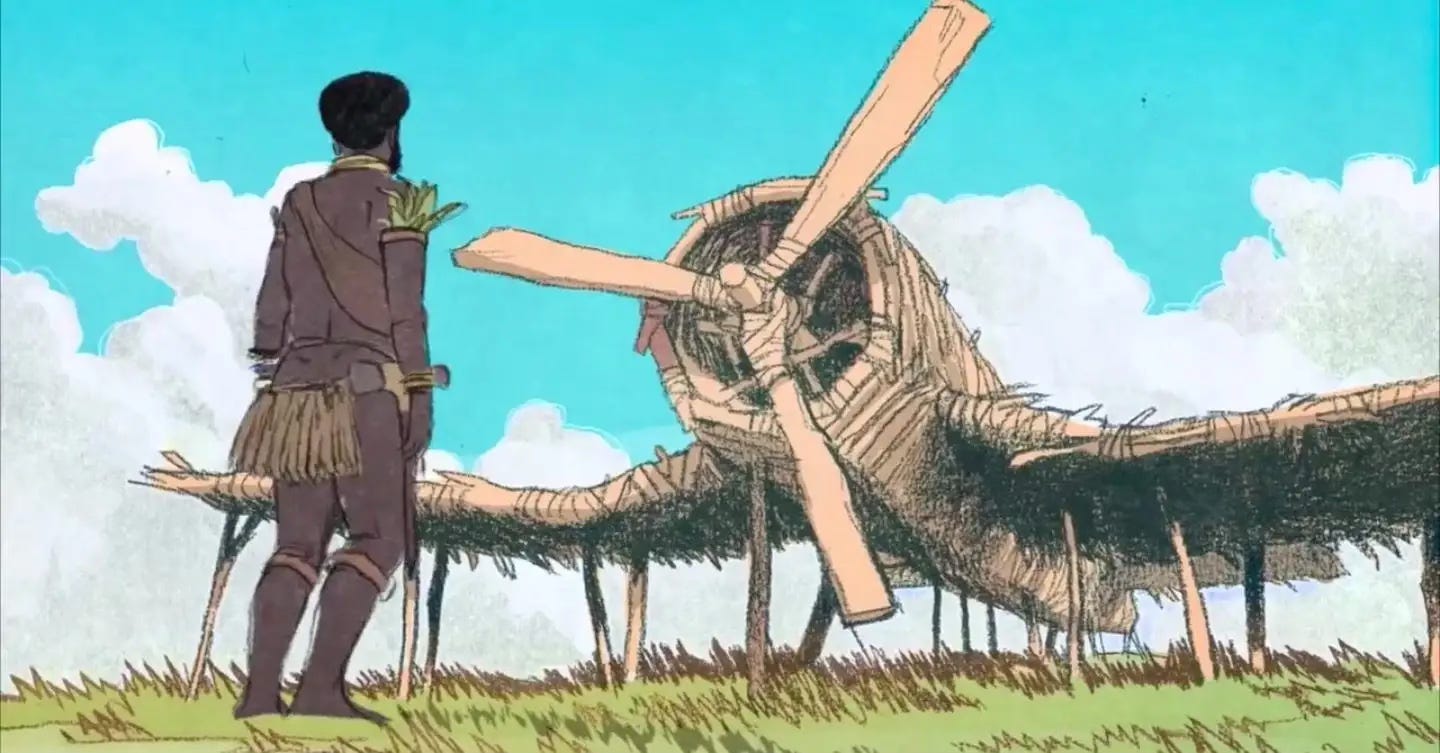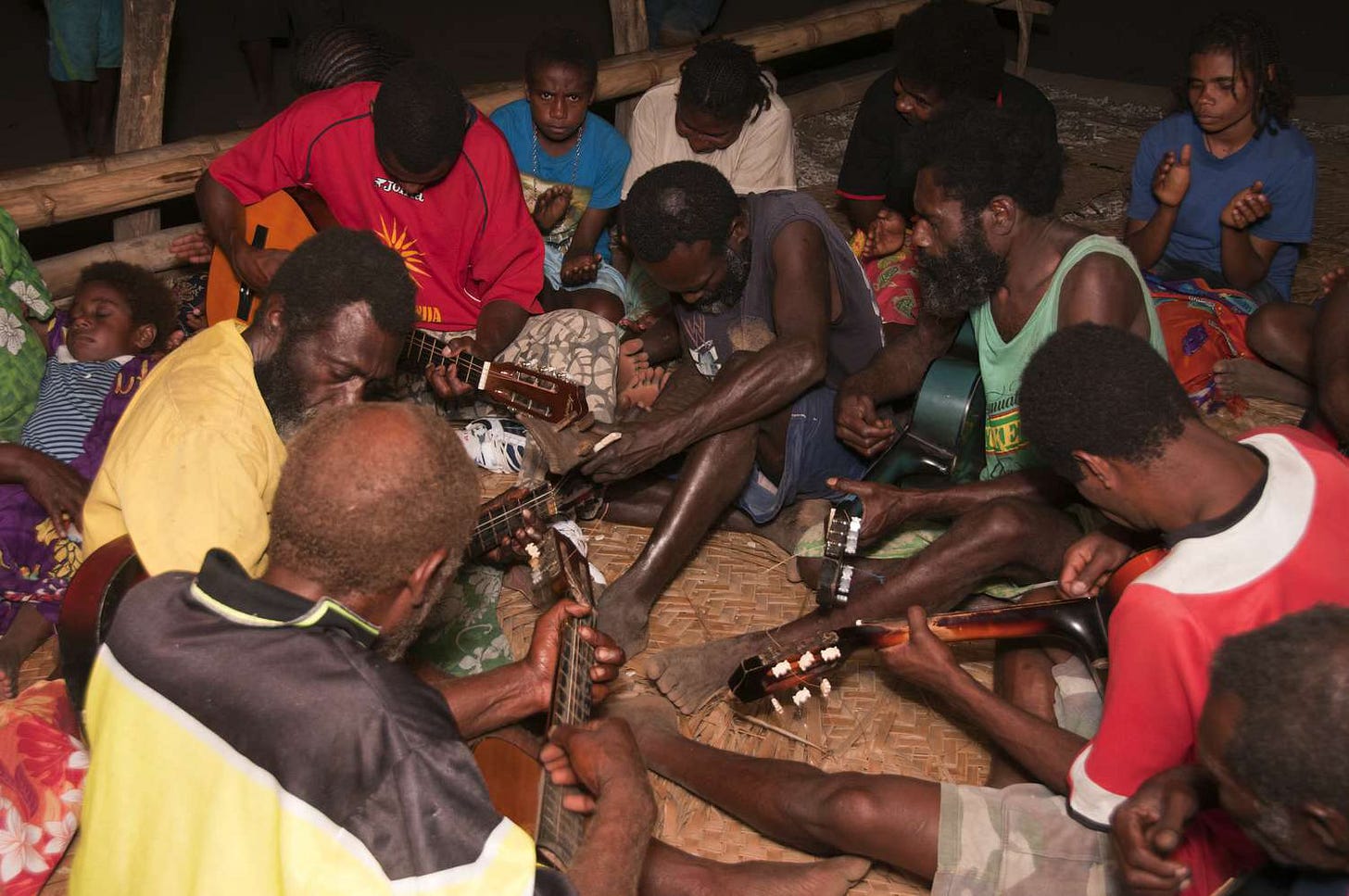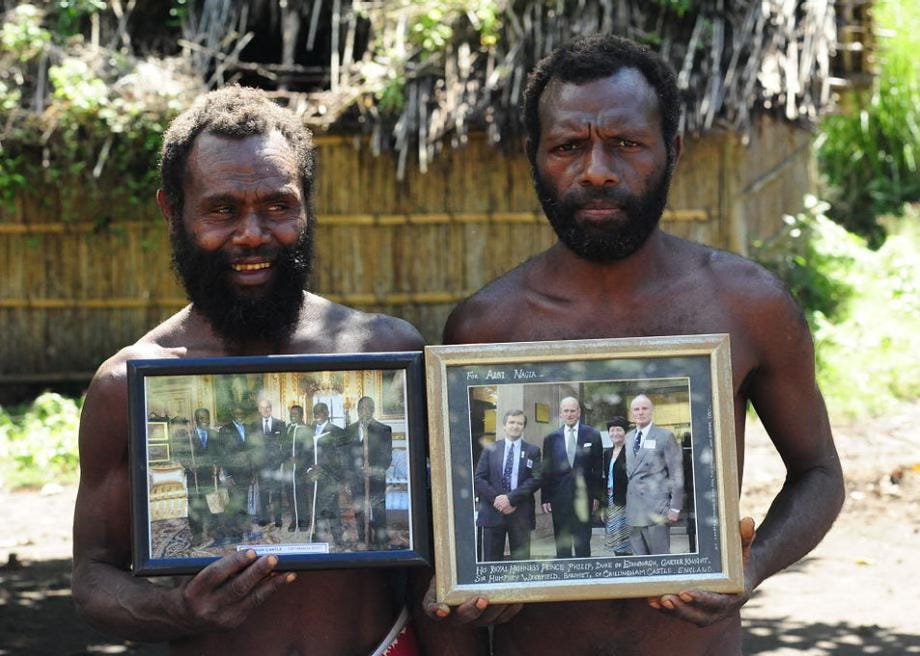Cargo, Colonies, and Cults: The Bizarre Worship of Western Goods and a British Prince
How Indigenous Communities in Melanesia Created Cargo Cults That Made Colonizers and Royals Into Divine Beings
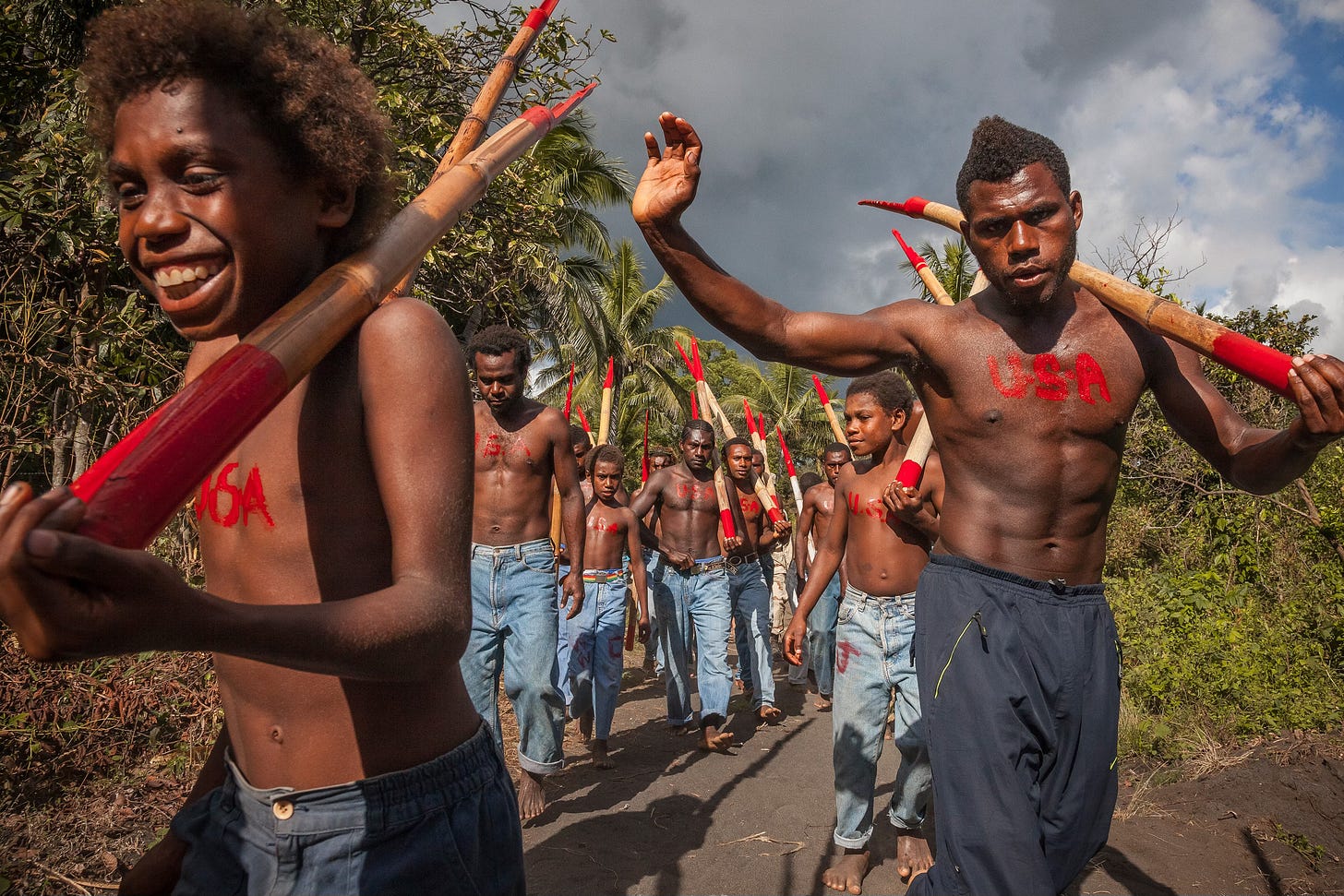
Cargo cults are a fascinating and unique sociocultural phenomenon that emerged primarily in Melanesia during the 19th and 20th centuries. These movements, which arose in response to colonial disruption, Western goods, and military influence, often revolved around the belief that material wealth, or "cargo," was a divine gift. Among these movements, the John Frum cargo cult, based on the island of Tanna in Vanuatu, is one of the most enduring and well-known. This article explores the origins, rituals, and lasting influence of the John Frum movement, placing it in the broader context of Melanesian cargo cults and their cultural impact.
Understanding Cargo Cults
Cargo cults developed as Melanesian societies encountered colonial powers, missionaries, and, during World War II, foreign military forces. The arrival of Western goods, including clothes, tools, and weapons, perplexed local populations who had no understanding of industrial production and commerce. The goods were often perceived as miraculous, prompting beliefs that these items were sent by deities or ancestral spirits. This perception led to the creation of cults that focused on the return of these goods, either through divine intervention or the arrival of foreign figures.
Key Features of Cargo Cults
Cargo as Divine Wealth: Indigenous people often interpreted Western goods—food, clothing, radios, and even weapons—as heavenly gifts from gods or spirits, meant to be shared with the local population.
Cultural Disruption: The sudden appearance of foreign goods and technologies disrupted traditional belief systems, prompting the creation of new religious frameworks that sought to explain this unearned wealth.
Imitative Rituals: Many cargo cults engaged in symbolic activities, such as creating mock airstrips, building bamboo replicas of airplanes, or performing military drills to attract the return of cargo-laden planes.
The John Frum Movement
The John Frum cargo cult, centered on the island of Tanna, emerged in the late 1930s but is believed by some to have been influenced by local religious practices dating back to the 1910s. At the heart of the John Frum movement is the belief in the return of John Frum, an American World War II serviceman who, according to the cult, will bring wealth, prosperity, and an end to the dominance of colonial forces.
John Frum as a Symbol
The figure of John Frum is tied to both local myths and colonial history. Some believe that the name "John Frum" is a misinterpretation of "John from America," derived from a U.S. serviceman’s introduction. According to others, John Frum was a spiritual vision induced by the psychoactive effects of kava, a plant with mild hallucinatory properties. In these interpretations, John Frum is also seen as a manifestation of Keraperamun, a god linked to Mount Tukosmera.
In the early 1940s, followers began to reject Western influences: they abandoned missionary churches, discarded money, and moved inland to reconnect with traditional ways of life. This marked the official rise of the John Frum cult. As a symbol of their faith, the followers constructed symbolic airstrips and bamboo planes, hoping to attract cargo from the skies, just as the Allied military had done during the war.
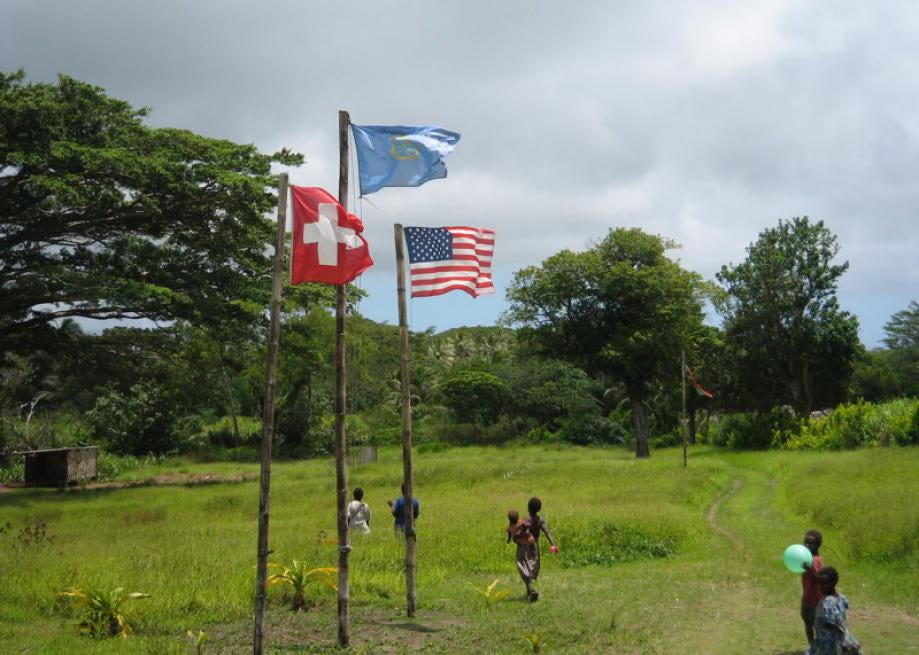
The John Frum movement is known for its intense and sustained rituals, including their unique 12-hour-long singing and music sessions. Followers gather every Friday, where they sing, play instruments, and engage in chants, all in the belief that these rituals will summon the return of John Frum and the cargo he is said to bring. The community comes together to perform these rituals, often starting in the morning and continuing throughout the day, reflecting their deep commitment to the movement.
As documented by Janet Newenham on her Instagram account (@janetnewenham), the Friday gatherings are communal and symbolic of the movement's enduring strength, even as the number of active followers has dwindled to fewer than 500 as of 2022. The intense, 12-hour sessions are a way for followers to reaffirm their belief in John Frum’s return and maintain the community’s cohesion and spiritual devotion.
John Frum Day and the Tanna Army
John Frum Day, celebrated every year on February 15, is a focal point of the movement. This day commemorates the expected return of John Frum. Followers participate in elaborate military-style parades, often wearing white T-shirts with the letters "T-A USA," referring to the Tanna Army USA, a ritualistic society founded in 1957. The Tanna Army performs symbolic drills, paying homage to the military influence that played a key role in the development of the cult. This day remains a major cultural and political event on the island, symbolizing both resistance to colonialism and a desire for a return to traditional practices.
Despite the decline in followers, the John Frum movement still maintains a significant presence in the cultural landscape of Tanna. It has also influenced local politics, with the Nagriamel party, which celebrates John Frum Day, continuing to play a role in the island's political life.
Political and Cultural Legacy
In the 1970s, as Vanuatu moved toward independence, the John Frum movement resisted the centralization of government, fearing that the influence of Western modernity and Christianity would undermine traditional practices. The Nagriamel political party, which emerged from the John Frum movement, continues to champion local customs and resist the forces of globalization.
The movement's influence also extended to the realm of politics, as leaders like Thitam Goiset—who served as the president of both the John Frum movement and Nagriamel—worked to ensure the political viability of the cult. Goiset’s rise to power was a significant moment in the movement's history, as it marked the involvement of a woman in a traditionally male-dominated leadership role.
The Prince Philip Movement
In a similar vein to the John Frum movement, the Prince Philip movement worships the late Duke of Edinburgh, who was believed to be a divine figure by the people of Tanna. The movement, which arose after Prince Philip's visits to the island, is another example of how Western figures have been deified in cargo cults. While the John Frum and Prince Philip movements differ in their specific beliefs, both reflect the local desire to reconcile Western influences with indigenous traditions.
Conclusion
The John Frum cargo cult, like other cargo cults in Melanesia, provides a powerful example of how indigenous communities adapt their beliefs in response to colonialism, globalization, and warfare. The movement's rituals, such as the 12-hour singing sessions and the annual John Frum Day parades, highlight the enduring cultural significance of these practices. Despite a dwindling following, the John Frum movement remains a symbol of resistance, resilience, and the ongoing search for justice and prosperity.
References
Lattas, Andrew. Cultures of Secrecy: Reinventing Race in Bush Kaliai Cargo Cults. University of Wisconsin Press, 1998.
Kaplan, Martha. Neither Cargo nor Cult: Ritual Politics and the Colonial Imagination in Fiji. Duke University Press, 1995.
Lindstrom, Lamont. Cargo Cult: Strange Stories of Desire from Melanesia and Beyond. University of Hawaii Press, 1993.
Worsley, Peter. The Trumpet Shall Sound: A Study of Cargo Cults in Melanesia. Palgrave Macmillan, 1957.
Tonkinson, Robert. "The John Frum Movement in Tanna." The Journal of Pacific History, vol. 6, no. 1, 1971, pp. 65-84.
Newenham, Janet. "John Frum Cargo Cult Rituals in Vanuatu." Instagram, @janetnewenham.
BBC News. "Prince Philip: The Vanuatu tribes mourning the duke." April 2021.
Otto, Ton. "Cargo Cults and the Globalization of Imagination." Ethnos, vol. 65, no. 1, 2000, pp. 5-24.
Berger, Claude-Philippe. "Traditional King of Tanna." Personal Interview, 2019.
Slate. "The Cargo Cults of Tanna Worship an American WWII Soldier and Prince Philip." Atlas Obscura, January 22, 2014. Link.



